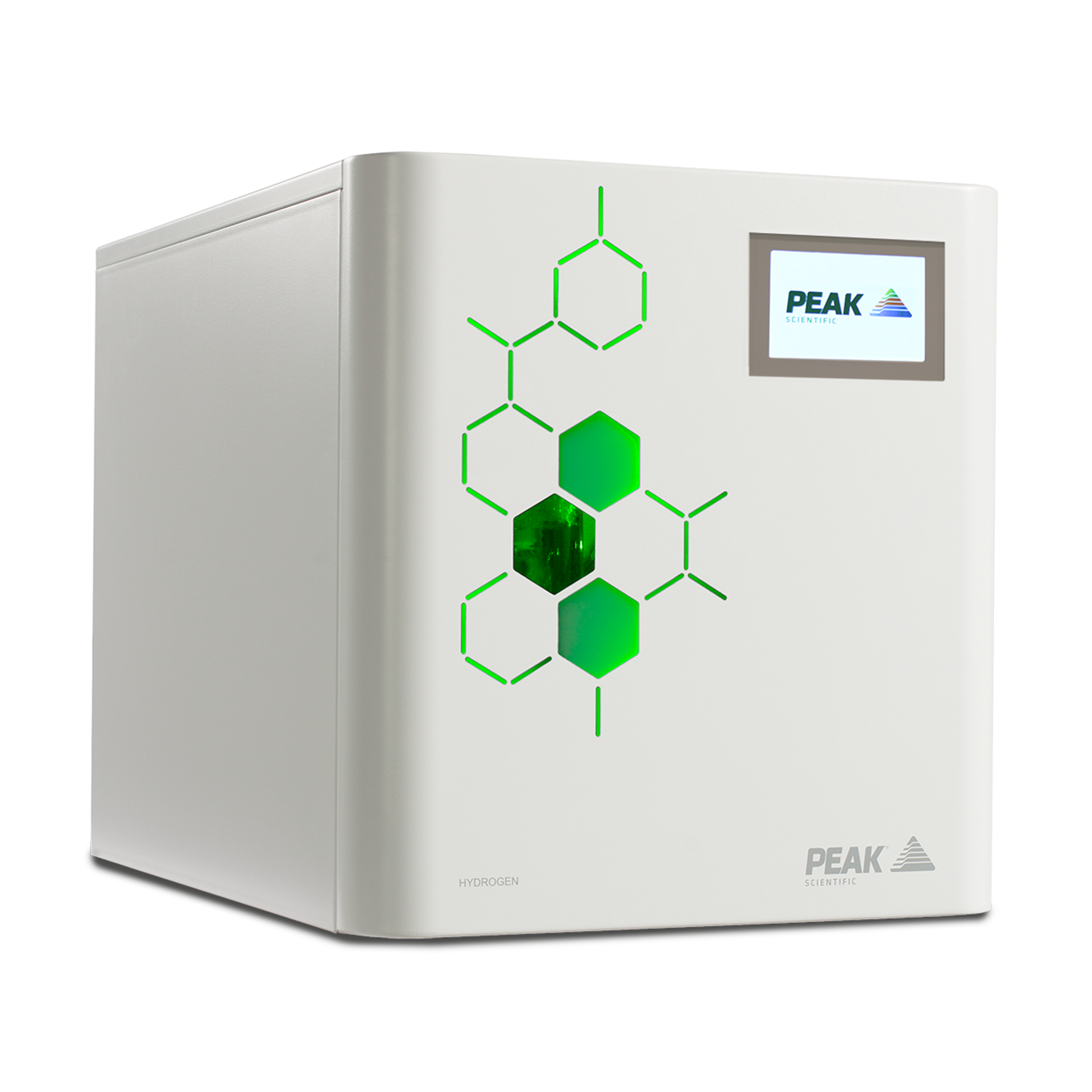Many laboratories are now prohibited from placing Hydrogen cylinders on their premises owing to health and safety restrictions. A PEAK Scientific Precision Hydrogen Trace generator is a safe alternative to gas cylinders whilst providing pure carrier gas (99.99999%* purity, moisture free), in quantities great enough to supply a number of GCs simultaneously.
*based on O2 content independently verified by National Physical Laboratory, UK

The Risks and Considerations of Hydrogen Cylinders
A PEAK Hydrogen generator can supply round-the-clock Hydrogen without the need to encounter the risks and time costs incurred by the use and handling of Hydrogen cylinders including:
- Cylinder changes - frequent changing of cylinders interrupts GC operation and can also increase the risk of contamination through ambient air entering the system.
- Cylinder storage – potential for leaks and explosion.
- Cylinder monitoring- to ensure that gas supply does not run out.
- Health and safety dangers - many associated health and safety issues with moving cylinders.
- Size - gas cylinders can take up a considerable amount of laboratory space.
Hydrogen Safety
The most significant risk with Hydrogen use is a leak into the laboratory environment raising the Hydrogen content to an explosive level. The safety benefit of a generator can be seen by looking at a theoretical example. The lower explosive limit (LEL) for Hydrogen is 4% in air. Therefore the LEL of a small hermetically sealed laboratory with a volume of 500m3 can be reached by emptying two 50L cylinders of Hydrogen. With a large enough leak this can be achieved in minutes. High pressure Hydrogen can also undergo auto-ignition when released rapidly from a cylinder. Since PEAK Hydrogen generators are designed to contain a minimal amount of Hydrogen (<400cc), it would take nearly 12 days to reach the LEL in the same lab. The construction of the Precision Hydrogen Trace generator conforms to CEI / OSHA regulations and it only produces gas when the application places a demand on the unit. The unit also meets the European Electromagnetic Compatibility and Low Voltage Directives. The Generator is CE approved and has the CE mark attached.
Safety Features of Precision Hydrogen Trace Generators
The Precision Hydrogen Trace generator has the following safety features to ensure safe and reliable operation:
- To avoid any build-up of Hydrogen from leaks inside the unit; the generator features forced air ventilation. This ensures that a Hydrogen/oxygen mixture cannot form inside the generator.
- On power-up the generator self-checks for internal leaks and if required it will shut down at the end of the System Check informing the operator with a visual alarm.
- The generator will detect any Hydrogen leaks that occur within the generator, the user’s application and gas lines. In the event of a major leak the generator will automatically shut down within 20 minutes.
- The Hydrogen pressure inside the generator should only reach a maximum of 7.5 bar (110psi) and this is controlled in two ways:
a. Gas pressure is monitored and controlled electronically by a pressure sensor
b. A mechanical pressure switch (Fail Safe) will electrically isolate the Hydrogen cell should the internal pressure exceed 7.5 bar (110psi) - When the generator is in alarm status the following occurs:
a. The current to the cell is stopped so no Hydrogen is generated therefore preventing a hazardous situation.
b. The over-pressure relief valve opens allowing the unit to depressurise.
c. An audible alarm will sound and a visual alarm relevant to the fault condition will be displayed. The generator can sense both internal and external leaks, excessive gas demand and lack of water.
H2 Detector Option
An H2 detector unit can be purchased along with the Precision Hydrogen Trace. The detector is intended for use with a GC and it is recommended that the detector unit is placed above the height of the GC outlet. The detector can be wall mounted. This unit is connected from the ‘In’ port at the rear on the detector, into the ‘H2 Detector’ port at the rear of the generator.
This connection will provide the detector unit with power and allows communication between the Precision Hydrogen Trace and the detector unit. The detector will take samples continuously and both the detector and the Precision Hydrogen Trace will sound an alarm if dangerous levels of Hydrogen are detected. In the rare case of a Hydrogen leak, the generator will shut down. Multiple detectors can be connected to one Precision Hydrogen Trace (maximum 4). If this is desired, connect the first detectors ‘Out’ port to the second detectors ‘In’ port, as illustrated below.
Automatic Filling
The Precision Hydrogen Trace generator uses an automatic water filling system, whereby sensors in the unit’s internal water tanks detect when the water level reaches a minimum. The tank then refills using a rear connection to an external deionised (DI) water supply. The unit should be connected to the DI water supply. Using the length of Tygon® tubing and the hose barb fitting from the fittings kit, the barb should be attached to the tubing. One end should then be connected to the water supply and the other to the Fill port at the rear of the Precision Hydrogen Trace generator.
Conclusion
Safety concerns surrounding Hydrogen cylinders, including leakage and explosions, have led to an increasing number of labs seeking an alternative solution. With many labs prohibiting the use of cylinders altogether, Hydrogen generators are now widely used. PEAK Scientific’s Precision Hydrogen Trace generator contains many safety features such as leak detection and automatic shutdown features and provides an economical, market- leading, total solution for your laboratory.

Ed Connor DR.SC. is GC-MS Application Specialist, PEAK Scientific, Inchinnan Business Park, Scotland, UK . Prior to joining PEAK in February 2013, Ed completed his Dr.Sc. at ETH Zurich in Switzerland using GC-MS to look at herbivore induced plant volatiles and their interaction with beneficial insects. He then joined the University of Zurich where his work focused primarily on volatile collection methods and analyses using GC-MS and GC-FID . +44 141 812 8100, econnor@peakscientific.com
Find out more about PEAK Scientific's hydrogen, nitrogen and zero air Precision series generators for GC or contact us.